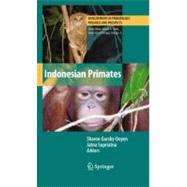
What is included with this book?
| Introduction | p. 1 |
| Indonesia's Apes | |
| Measuring Performance of Orangutan Protection and Monitoring Unit: Implications for Species Conservation | p. 9 |
| Communication, Culture and Conservation in Orangutans | p. 23 |
| The Natural History of Sumatran Orangutan (Pongo abelii) | p. 41 |
| Javan Gibbon (Hylobates moloch): Population and Conservation | p. 57 |
| Siamang Socioecology in Spatiptemporally Heterogenous Landscapes: Do “Typical” Groups Exist? | p. 73 |
| Impact of Forest Fragmentation on Ranging and Home Range of Siamang (Symphalangus syndactylus) and Agile Gibbons (Hylobates agilis) | p. 97 |
| Behavioural Ecology of Gibbons (Hylobates albibarbis) in a Degraded Peat-Swamp Forest | p. 121 |
| Effect of Habitat Quality on Primate Populations in Kalimantan: Gibbons and Leaf Monkeys as Case Studies | p. 157 |
| Indonesia's Monkeys | |
| Predator Recognition in the Absence of Selection | p. 181 |
| The Relationship Between Nonhuman Primate Densities and Vegetation on the Pagai, Mentawai Islands, Indonesia | p. 199 |
| Proboscis Monkey (Nasalis larvatus): Bio-ecology and Conservation | p. 217 |
| Pests, Pestilence, and People: The Long-Tailed Macaque and Its Role in the Cultural Complexities of Bali | p. 235 |
| The Not-So-Sacred Monkeys of Bali: A Radiographic Study of Human-Primate Commensalism | p. 249 |
| Male-Male Affiliation in Sulawesi Tonkean Macaques | p. 257 |
| Ecology and Conservation of the Hose's Langur Group (Colobinae: Presbytis hosei, P. canicrus, P. sabana): A Review | p. 269 |
| Thomas Langurs: Ecology, Sexual Conflict and Social Dynamics | p. 285 |
| Dominance and Reciprocity in the Grooming Relationships of Female Long-Tailed Macaques (Macaca fascicularis) in Indonesia | p. 309 |
| Selamatkan Yaki! Conservation of Sulawesi Crested Black Macaques Macaca nigra | p. 343 |
| Indonesia's Prosimians | |
| The Function of Scentmarking in Spectral Tarsiers | p. 359 |
| The Population Ecology of Dian's Tarsier | p. 371 |
| Using Facial Markings to Unmask Diversity: The Slow Lorises (Primates: Lorisidae: Nycticebus spp.) of Indonesia | p. 383 |
| Conclusions | p. 397 |
| Index | p. 401 |
| Table of Contents provided by Ingram. All Rights Reserved. |
The New copy of this book will include any supplemental materials advertised. Please check the title of the book to determine if it should include any access cards, study guides, lab manuals, CDs, etc.
The Used, Rental and eBook copies of this book are not guaranteed to include any supplemental materials. Typically, only the book itself is included. This is true even if the title states it includes any access cards, study guides, lab manuals, CDs, etc.